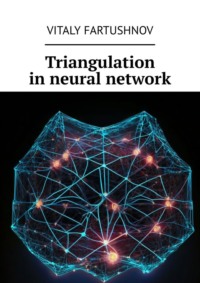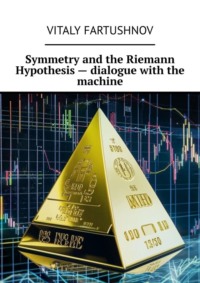
Полная версия
Gold trader. The Relationship Between Even Powers of the Gaussian Integral, the Gamma Function, and Fibonacci Levels

Gold trader
The Relationship Between Even Powers of the Gaussian Integral, the Gamma Function, and Fibonacci Levels
Vitaly Fartushnov
© Vitaly Fartushnov, 2025
ISBN 978-5-0067-7881-8
Создано в интеллектуальной издательской системе Ridero
Even powers of the Gauss integral connection with the gamma function
The relationship between even powers of the Gauss integral and the gamma function is expressed as follows:
Let us consider an integral of the form

where is an even degree.

This integral is expressed in terms of the gamma function as follows:

or, using the properties of the gamma function:

Replacing the variable $ t = x^2 $ leads to the gamma function:

Thus,

– Even moments of the Gaussian integral are expressed through the gamma function of a half-integer argument.
– For the general case: where for standard Gauss $ m=2n,,a=1,,b=2 $ [1] [2].

This shows the direct connection between even powers of the Gauss integral and the values of the gamma function, and explains why the values for half-integer arguments are expressed in terms of $ \sqrt {\pi} $ [1] [2].
– For example, for $ n=0 $ (that is, the standard Gauss integral):

– For $ n=1 $:

That is, the values of even Gaussian moment integrals are directly expressed through the gamma function for half-integer arguments [1] [2].
Examples of use :

⁂
List the literature on this topic
The main sources on the topic of Gauss integrals with even powers and related topics of quadratures, calculations and applications are:
– Fichtenholz G.M. «Course of Differential and Integral Calculus», v.2. Classic textbook, examines in detail Gaussian integrals, their properties and calculations [3].
– Kraynov V.A. «Numerical Methods for Calculating a Definite Integral». The manual examines methods for exact and approximate calculation of integrals, including Gaussian integrals, discusses accuracy for even-degree polynomials, and provides formulas [4].
– Fedotov AA «Numerical methods of integration». Modern manual with practical examples of numerical calculation of Gaussian integrals and their applications [5].
– Pastukhov D.F. «Gauss quadratures. Integral equations». Methodical instructions for the construction and application of Gauss quadrature formulas for calculating integrals of polynomials even of high degree [6].
– Dobrynina S.V. «Quadrature and cubature formulas». The manual contains practical tasks and analysis of the rules of approximate integration, including Gauss’s formulas for integrals with weights and polynomials [7].
– Arushanyan I.O. «Algorithms for approximate calculation of integrals». Methods for calculating integrals with various degrees of accuracy are discussed, including the use of even powers in Gaussian integrals [8].
These books and manuals are suitable for an in-depth study of the calculation and theory of Gaussian integrals, their properties and applications.
⁂
Theoretical foundations of quadrature formulas
Quadrature formulas are a classic mathematical tool for the approximate calculation of definite integrals over function values at a finite number of points. Their main purpose is to replace the calculation of the integral with a sum, where the coefficients and choice points (nodes) are selected to achieve maximum accuracy on a certain class of functions [9] [10] [11].
General form of the quadrature formula
Any quadrature formula usually has the following form:

Where:
– — formula nodes (points at which the function is calculated),

– — weights (coefficients with which the function value at the nodes is taken).

Theoretical Provisions
– The accuracy of a quadrature formula is determined by the class of functions for which the formula gives the exact value of the integral. Usually these are polynomials of degree no higher than a certain value.
– The error (remainder term) of the quadrature formula shows how accurately the integral is approximated [10] [12].
– Selection of nodes and weights: For example, in the Newton—Cotes formulas, the nodes are equidistant, while in the Gauss formulas, they are the roots of orthogonal polynomials (for example, Legendre polynomials for the classical integral on a segment), which allows achieving the highest algebraic degree of accuracy – for nodes [11].



– Historical background: methods of approximate integration arose in the times of Newton and Leibniz. The construction of classical formulas (rectangles, trapezoids, Simpson) is based on replacing the function inside the segment with some simple approximation (polynomial) and integrating this approximation [10].
Types of quadrature formulas
– Interpolation quadrature formulas: are based on the interpolation of a function (usually a polynomial one) [11].
– Compound (interval partitioning): a long interval is divided into parts, and a simple formula (such as the trapezoid or Simpson compound formula) is applied to each part [12] [11].
– Weighted quadrature formulas are used when the integrand contains singularities (e.g., singularities or rapid growth) [10] [13].
Error and degree of accuracy
– The degree of accuracy is the highest degree of a polynomial for which the formula gives an exact integral.
– The error is estimated through the upper bound of the high-order derivatives of the integrand (usually the Taylor residue formula) [11] [10] [9].
Examples
– Rectangles:

– Trapezius:

– Simpson: exact for polynomials up to degree [9] [12]
Summary
A quadrature formula is the result of a strictly mathematical construction in which the choice of nodes and weights results in a compromise between accuracy and computational simplicity. The entire theory of quadrature formulas is reduced to the problem of optimally approximating an integral by a summation function with the highest possible accuracy at minimum computational costs [11] [10] [9].
⁂
The Gauss integral is equal to the Gamma function
The relationship between the Gauss integral and the gamma function is expressed through integrals of powers of $ x $ with an exponential function and a change of variables. The classical Gauss integral looks like this:

The gamma function by definition is:

[14] [15] [16]
For certain values of the argument, this function calculates integrals that are very close in form to Gaussian integrals. For example, for integrals of the form:

the expression can be written using the gamma function:

This means that the «Gaussian» type integrals with even and odd powers of $x$ are directly related to the gamma function of a half-integer (fractional) argument [14] [17].
The Gaussian integral is a special case of this expression for and. Then



or, what is the same:

That is, [14] [17].

So:
– The Gauss integral is expressed in terms of the values of the gamma function, especially in the case of non-integer (usually half-integer) arguments.
– A more general formula relates integrals of the form with and parameter [14] [17].



These connections are actively used for calculations in probability theory, physics and mathematics.
⁂
The relationship between the Gauss integral and the gamma function
The connection between the Gauss integral and the gamma function is evident in the calculation of integrals of the form $ \int_0^ {\infty} x^ {\alpha} e^ {-ax^2} dx $, which can be expressed directly in terms of the gamma function with a half-integer argument:

Here $ a> 0 $, $ \alpha> -1 $, and $ \Gamma (z) $ is the gamma function.
Classical Gauss integral:

is a special case when and, but taken along the entire axis. For the half-interval:



which is consistent with the fact that.

Thus:
– All integrals of the form are expressed through the -function with argument.



– The value of the Gaussian integral is nothing more than the definition of the gamma function.


This connection allows one to calculate the so-called moments of the normal distribution and to use the results for analytical and numerical problems in mathematics, statistics and physics.
Analyze these equations
The figure shows important integrals associated with the Gaussian function $ e {-x 2} $ and its powers, as well as their analytical expressions.
Analysis of Equalities
– Type of integrals
Most integrals have the following form (for the entire axis or half-axis):

where $ n $ is a non-negative integer.
– Odd degrees

This is true because the function is odd: even powers are even, odd powers are odd, and $ e {-x 2} $ is even. The integral of an odd function on a symmetric interval is zero.
– Even powers
Integrals of even powers form a non-empty sequence:
– For $ n=0 $:

– For $ n=2 $:

– For $ n=4 $:

– and so on.
This confirms the conclusions from the previous conversation: the values of even powers of Gauss integrals are expressed through the factors $ \sqrt {\pi} $ and factorial expressions (double factorial or gamma function).
– Relationship with gamma function
Analytical expressions are also written in the form:

or

This provides a universal formula for all even $ n $.
– Formulas for the half-shaft
On the half-axis (from 0 to infinity) the integrals are expressed through the $ \Gamma $-function with a half-integer argument, usually with a coefficient $ \frac {1} {2} $.
– Conclusions
– Integrals of odd degrees on a symmetric interval are always equal to zero.
– Integrals of even degrees are expressed in terms of factorials or values of the gamma function and are multiples of $ \sqrt {\pi} $.
– The formulas in the table are classical and are widely used in mathematics, physics and statistics for calculating the moments of a normal distribution and in calculations with Gaussian functions.
– They illustrate the fundamental connection between the integrals of powers of the function $ e {-x 2} $ and the gamma function.
If you need a more specific analysis of any expression, please specify the number or form.
⁂
Find the relationships in the equations in these images
The provided images show interrelated equalities that reveal the analytical properties of Gauss integrals and their connection with the gamma function. Let’s consider the main relationships and patterns:
1. Gaussian integrals and even powers
In the first image and in the second, the list of integrals with even and odd powers of the variable $ x $ under the exponent $ e {-x 2} $:
– For odd powers of $ x {2n+1},e {-x^2} $ the integrals over the entire axis are equal to zero, which is due to the oddness of the function with respect to $ x $.
– For even powers of $ x {2n},e {-x^2} $ the integrals are expressed in terms of numbers that contain products of factorials and $ \sqrt {\pi} $. For example:
– $ \int_ {-\infty} ^\infty e {-x 2} dx = \sqrt {\pi} $
– $ \int_ {-\infty} ^\infty x^2 e {-x 2} dx = \frac {1} {2} \sqrt {\pi} $
– $ \int_ {-\infty} ^\infty x^4 e {-x 2} dx = \frac {3} {4} \sqrt {\pi} $
2. Relationship with the gamma function
Both images contain an expression of the general form:

And for the entire interval:

This allows us to write all even moments of the distribution at once via the gamma function of a half-integer argument. These equalities are systematized: each step from $ n $ to $ n+1 $ correctly passes according to the gamma function formula.
3. Calculated values and automation
The first image shows the calculation of the ratio

and we get $ 1.772… $ (the error should probably just be $ \sqrt {\pi} $), which coincides with the value $ \Gamma (1/2) $, illustrating that all specific numerical values are calculated via the gamma function and π.
4. Recurrence relations and factorials
The second image shows formulas with products of factorials and simple fractions:

This expression is related to the gamma function by the formula:

That is, all the entries in the images agree on this formula (factorial, double factorial, gamma function, as well as specific values for small $ n $).
5. Classical meanings – special cases
Numeric values (e.g., $ \sqrt {\pi} $, $ \frac {1} {2} \sqrt {\pi} $, $ \frac {3} {4} \sqrt {\pi} $) are special cases of the general formula for integer values of degree $ n $.
6. Practical connection
– All of the above equalities illustrate a fundamental connection: Gauss integrals with even powers are the values of the gamma function at half-integer points.
– These formulas are used in calculating the moments of normal distributions, probability and physical calculations (for example, to calculate average values in quantum mechanics and probability theory).
In summary:
The equalities in the images form a single hierarchical system, where the integrals of even powers of the Gaussian function are expressed through the gamma function of a half-integer argument and are related to factorials. All of them are closely intertwined and coordinated both analytically and numerically, which is confirmed by the calculations given in the images [18] [19].
⁂
Analyze the formula data in the screenshot and write the connection with the gamma function
The screenshot shows the calculation of the expression and its numerical result (). Let’s look at how this formula relates to the gamma function and the broader context of Gaussian integrals:


1. Expression structure
– — a combination of two operations: finding the root of the ratio and 7, then multiplying by.



2. Relationship with the gamma function

– closely related to the gamma function:

—

– In general: For :



3. Why does division by 7 appear?
– If we consider the generalized Gaussian integral with parameter: – at: – then it appears directly from the standard Gaussian formula.




4. Multiplication by

– The multiplication by here is just a numerical example – perhaps to demonstrate further calculations, or to show the moment (average value) of a function multiplied by the cosine.

5. Generalization: any function of the form

– For any positive: – it is clear that this is just a coincidence.




Conclusion:
Each root of the form in this and similar screenshots is associated with a gamma function with a half-integer argument (). All such formulas come from the general connection between Gauss integrals and the gamma function. The constant is added for illustration, and the basis is the direct connection of Gauss integrals with the gamma function.



⁂



